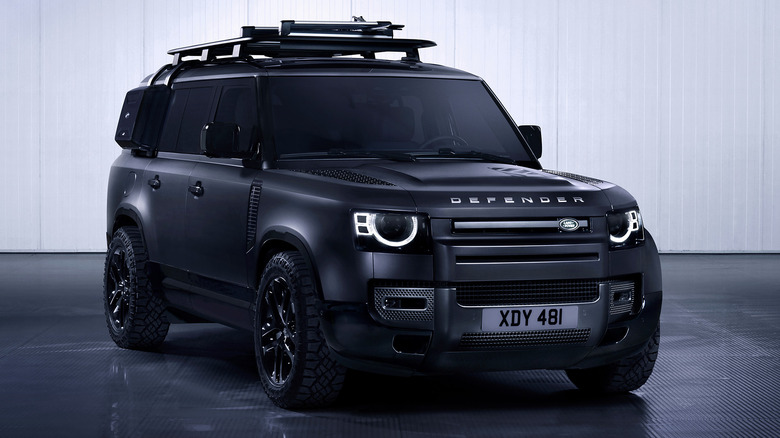Land Rover Defender Vs Discovery: The Biggest Differences
When Land Rover launched the latest Defender, codenamed L663, it completely changed the model's basic formula, which had stayed the same since the 1983 Defender. That one kept the formula of the 1948 original. The new model went from a truck-like body-on-frame construction with solid axles to a unibody design with independent suspension.
It is built on the same D7 platform as many other Jaguar-Land Rover vehicles, including the Land Rover Discovery. This means the latest generations of the Defender and Discovery share the same underpinnings, engines, and technologies, and, for the first time in the two nameplates' history, these two vehicles, from the same manufacturer, might end up being cross-shopped.
Don't think they are the same vehicle with a different skin because there are still many differences between the Defender and Discovery. The designs are nothing alike, with the Defender adopting and reinterpreting many classic design cues from previous generations. At the same time, the Discovery treads new ground for Land Rover design with its bold asymmetrical approach.
You can get the Defender in three different body styles, which broadens its appeal significantly, while you can only get the Discovery as a big three-row family SUV. The Land Rover Discovery Sport doesn't count in this company because it's built on a different front-wheel drive-based platform.
There's also the question of off-road ability. The Defender has been traditionally good on rough terrain, but in losing its separate chassis, it has also lost some of the ruggedness and sheer off-road ability it was known for. The Discovery is also a competent off-roader but not as good as the new Defender.
Body styles and engines
L663 Defenders come in three flavors: the two-door 90, the four-door 110, and the extended-wheelbase 130. The smallest variant is also the best at going off-road because it's lightest and has the best angles for traversing tricky obstacles. The Defender 110 is the most well-balanced version, offering four doors and seating for up to seven.
The Defender 130 has the highest load-carrying ability — it still offers 13.7 cubic feet of cargo volume with the third row up, compared to the 110's 8.2 cubic feet in the Defender 110. With the third row down, space in the 130 increases to 42.5 cubic feet and in the 110 to 32.3 cubic feet.
The Land Rover Defender and Discovery share the same 2-liter four-cylinder and 3-liter six-cylinder gasoline and diesel units, but the engine ranges aren't identical. None of the diesels are available in America, where the entry-level power plant for both models is a P300 2-liter turbo engine with 295 horsepower.
You can specify an optional 3-liter inline-six turbo for both, which in the Discovery comes as the 355-horsepower P360 mild hybrid. In the Defender, the same engine is called the P400 and is pushed to 395 horsepower. It can optionally be equipped with a mild hybrid system for a minor efficiency improvement. The Defender is available with a 525-horsepower 5-liter V8 (not available in the Discovery), which pushes the 110 version of the Defender from 0 to 60 mph in 4.6 seconds.
In Europe, the Defender is also offered as the P400e plug-in hybrid, which pairs the same 2-liter turbo engine with an electric motor to produce 395 horsepower. The Defender PHEV has a 19.2 kWh battery, giving it a claimed WLTP range of 27 miles.
Off-road ability
Being Land Rovers, the Defender and the Discovery are designed to be competent off-roaders right out of the box. However, the Defender has some of the best approach, departure, and breakover angles of any vehicle, which puts it in the same league as a Jeep Wrangler. The Discovery is an excellent off-roader for a three-row family SUV, but it's not been designed to match the Defender.
The off-road focus is evident in the Defender's exterior design, too. It has very short overhangs, and its bumpers are designed to minimize the chance that they could snag on something while off-roading. The Defender also has an inch of extra ground clearance (for models equipped with air suspension), further enhancing its ability to go over obstacles to levels the Discovery can't match.
However, the tradeoff is the Defender isn't as accomplished a cruiser as the Discovery, which feels much more car-like to drive on the road. Take both vehicles on the highway, and the Discovery will feel quieter and more settled, and its premium interior will feel more comfortable.
How much you plan to take it off-road and whether you like the Discovery's unusual design (especially in the rear) will be deciding factors in choosing one of these vehicles over the other. Price probably won't factor in the decision since Defender 110 and Discovery start at around $60,000. You can get the two-door Defender 90 for about $56,000, but it's nowhere near as practical as the other two, so it addresses a different type of buyer.


